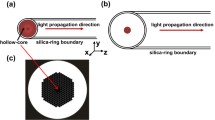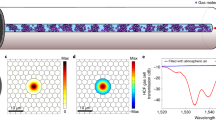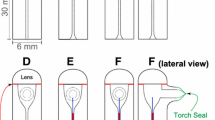Abstract
Gas-phase materials are used in a variety of laser-based applications—for example, in high-precision frequency measurement1,2, quantum optics and nonlinear optics3,4. Their full potential has however not been realized because of the lack of a suitable technology for creating gas cells that can guide light over long lengths in a single transverse mode while still offering a high level of integration in a practical and compact set-up or device. As a result, solid-phase materials are still often favoured, even when their performance compares unfavourably with gas-phase systems. Here we report the development of all-fibre gas cells that meet these challenges. Our structures are based on gas-filled hollow-core photonic crystal fibres, in which we have recently demonstrated substantially enhanced stimulated Raman scattering5,6, and which exhibit high performance, excellent long-term pressure stability and ease of use. To illustrate the practical potential of these structures, we report two different devices: a hydrogen-filled cell for efficient generation of rotational Raman scattering using only quasi-continuous-wave laser pulses; and acetylene-filled cells, which we use for absolute frequency-locking of diode lasers with very high signal-to-noise ratios. The stable performance of these compact gas-phase devices could permit, for example, gas-phase laser devices incorporated in a ‘credit card’ or even in a laser pointer.




Similar content being viewed by others
References
Luiten, A. N. (ed.) Frequency Measurement and Control (Springer, Berlin, 2001)
Hall, J. L. Frequency stabilized lasers—a parochial review. Proc. SPIE 1837, 2–15 (1992)
Hentschel, M. et al. Attosecond metrology. Nature 414, 509–513 (2001)
Steinmeyer, G., Sutter, D. H., Gallmann, L., Matuschek, N. & Keller, U. Frontiers in ultrashort pulse generation: Pushing the limits in linear and nonlinear optics. Science 286, 1507–1512 (1999)
Benabid, F., Knight, J. C., Antonopoulos, G. & Russell, P. S. J. Stimulated Raman scattering in hydrogen-filled hollow-core photonic crystal fiber. Science 298, 399–402 (2002)
Benabid, F., Bouwmans, G., Knight, J. C., Russell, P. S. J. & Couny, F. Ultra-high efficiency laser wavelength conversion in gas-filled hollow core photonic crystal fiber by pure stimulated rotational Raman scattering in molecular hydrogen. Phys. Rev. Lett. 93, 123903 (2004)
Russell, P. Photonic crystal fibers. Science 299, 358–362 (2003)
Marcuse, D. Loss analysis of single-mode fiber splices. Bell Syst. Tech. J. 55, 703–718 (1977)
Dushman, S. Scientific Foundations of Vacuum Technique (John Wiley & Sons, New York, 1962)
Hansch, T. W. in The Hydrogen Atom (ed. Hansch, T. W.) 93–102 (Springer, Berlin, 1989)
Huber, A. et al. Hydrogen-deuterium 1S–2S isotope shift and the structure of the deuteron. Phys. Rev. Lett. 80, 468–471 (1998)
Quinn, T. J. Practical realization of the definition of the metre, including recommended radiations of other optical frequency standards (2001). Metrologia 40, 103–133 (2003)
Nakagawa, K., de Labachelerie, M., Awaji, Y. & Kourogi, M. Accurate optical frequency atlas of the 1.5 µm bands of acetylene. J. Opt. Soc. Am. B 13, 2708–2714 (1996)
Swann, W. C. & Gilbert, S. L. Pressure-induced shift and broadening of 1510–1540-nm acetylene wavelength calibration lines. J. Opt. Soc. Am. B 17, 1263–1270 (2000)
MacAdam, K. B., Steinbach, A. & Wieman, C. A narrow band tunable diode laser system with grating feedback, and a saturated absorption spectrometer for Cs and Rb. Am. J. Phys. 69, 1098–1111 (1992)
Wieman, C. E. & Hollberg, L. Using diode lasers for atomic physics. Rev. Sci. Instrum. 62, 1–20 (1991)
Onae, A. et al. Optical frequency link between an acetylene stabilized laser at 1542 nm and an Rb stabilized laser at 778 nm using a two-color mode-locked fiber laser. Opt. Commun. 183, 181–187 (2000)
Acknowledgements
The support of the UK Engineering and Physical Sciences Research Council (EPSRC) is acknowledged. F.B. thanks A. Luiten and M. Maric for discussions on frequency stabilization. F.B. is an EPSRC Advanced Research Fellow.
Author information
Authors and Affiliations
Corresponding author
Ethics declarations
Competing interests
The authors declare that they have no competing financial interests.
Rights and permissions
About this article
Cite this article
Benabid, F., Couny, F., Knight, J. et al. Compact, stable and efficient all-fibre gas cells using hollow-core photonic crystal fibres. Nature 434, 488–491 (2005). https://doi.org/10.1038/nature03349
Received:
Accepted:
Issue Date:
DOI: https://doi.org/10.1038/nature03349
- Springer Nature Limited
This article is cited by
-
Probing molecules in gas cells of subwavelength thickness with high frequency resolution
Nature Communications (2024)
-
Towards high-power mid-IR light source tunable from 3.8 to 4.5 µm by HBr-filled hollow-core silica fibres
Light: Science & Applications (2022)
-
Demonstration of an integrated nanophotonic chip-scale alkali vapor magnetometer using inverse design
Light: Science & Applications (2021)
-
Recent Advances in Spectroscopic Gas Sensing With Micro/Nano-Structured Optical Fibers
Photonic Sensors (2021)
-
Intense Brillouin amplification in gas using hollow-core waveguides
Nature Photonics (2020)





